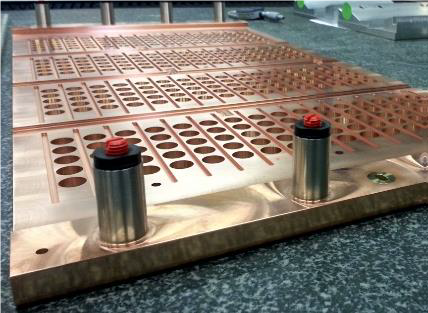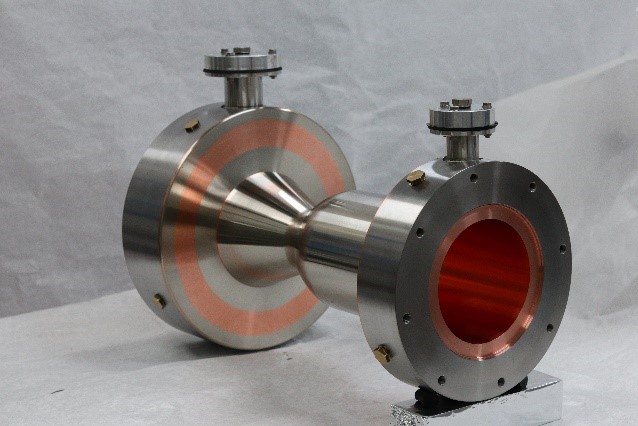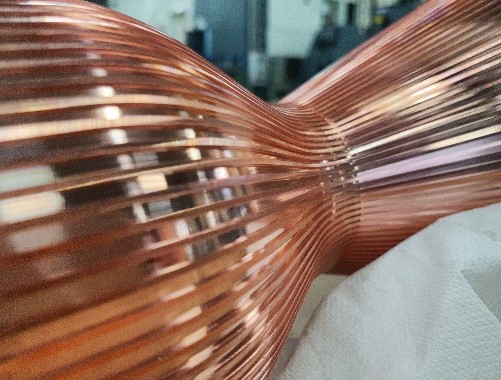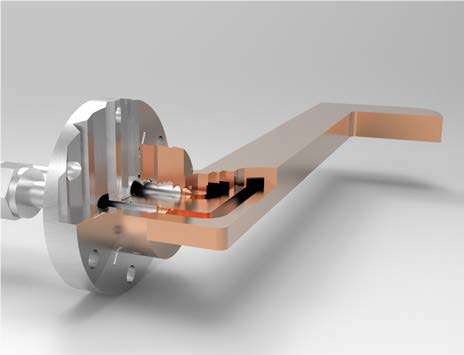CECOM heritage in nuclear fusion market started in early 2010s when the company changed its strategy to address the Big-Science market and when first manufactured the of extraction grids for JET (Joint European Torus). Based on copper deposition, this industrial method has then been implemented with F4E during the Spider project to manufacture the grids for the Beam Source and the majority of the mechanical components. This technology is mature in CECOM and is now tested and implemented to tackle new challenges in non-fusion projects.
A winning solution for space thrust chambers with internal cooling channels
The copper plating of components with internal cooling channels has been found attractive for space propulsion applications. Especially, the liquid propellant engines with highest performances use a pre-combustion stage to feed the turbopumps, where the pre-heating of the fuel takes place by means of the combustion chamber itself, that acts like a heat exchanger and takes advantage from the regenerative cooling.
A prototype of a regenerative thrust chamber has been developed and tested in collaboration with CIRA (Italian acronym for « Italian Aerospace Research Centre »).
The use of the copper plating leads to a more compact engine that exploits better the energy content of the propellant to produce thrust. Really similar to the one implemented for fusion purposes, this process is based on the electrodeposition of copper and nickel. The adoption of this “cold” method to cover the channels enabled to reduce the overall weight of the engine significantly. This new approach could be a game-changer solution in space industry and micro-launchers market, thanks to its greater repeatability and scalability (if compared to brazing), thermal and stress-free manufacturing process and more efficient use of the mass of the propellant.
Brazing-free components in ultra-high vacuum for particles accelerators
In the particle acceleration sector, the ESRF (European Synchrotron Radiation Facility), located in Grenoble (France), has also successfully tested the electroformed copper to produce a cooled component (collimator) in ultra-high vacuum environment without using brazing or welding. The prototype, tested up to 20 bar of internal pressure, has a special junction between the copper part and the Stainless-Steel flange developed for avoiding the water to arrive in contact with vacuum even in case of failure of the device. The main added value of CECOM know-how consists in avoid thermal stresses on the materials during the fabrication process (mechanical characteristics of the copper part will not be altered as in a heat-based process), reducing costs while increasing reliability of the components and facilitating the joining of dissimilar materials.
Results are promising and CECOM is now willing to encourage the particle accelerators organizations to consider this manufacturing know-how during the very first beginning of the design phase to perceive its added value.
Gained visibility, new contracts and recognized expertise in Europe: how F4E project brought CECOM to a next level
An important part of CECOM heritage gained during the collaboration with F4E during the SPIDER project is the ability to joint heterogeneous materials with a cold method: mechanical preparation and copper deposition. The SME is now clearly identified as one of the few entities in Europe mastering this manufacturing approach and is now contacted on a regular basis since the adaptation to new requirements doesn’t mean major investments on the facility and infrastructure and can be performed quite fast.
This renowned expertise has led to an increased visibility among fusion and non-fusion industries, signature of new contracts and revenue increase (collaboration with CIRA continues with new contracts). For instance, the opening of the space market and the series production of thrust chambers may represent a booster for CECOM in terms of sales and jobs and double the turnover in the coming years.



